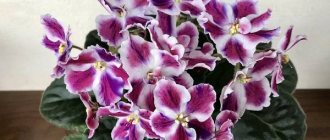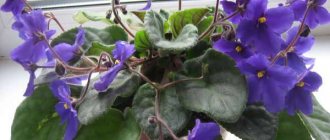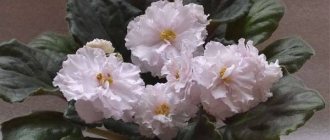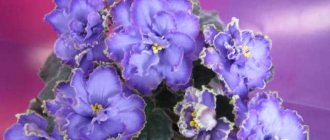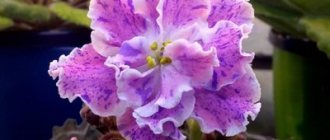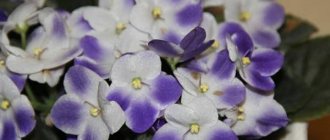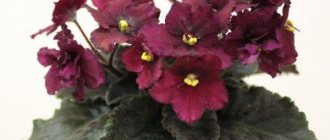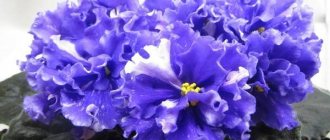Uzambara violets have long become favorites of flower growers ; world-famous breeders, as well as novice specialists in this field, are constantly working on their breeding and obtaining new varieties.
And each of them necessarily has one or more varieties of violets with the adjective “favorite” in the name. Such names are given to especially successful hybrids or specimens that are somehow extremely dear to their creator, in other words, the favorite varieties of violets.
All these violets differ from each other in decorative qualities, have some peculiarities in their content, and
are united into one group thanks to the tender affection of selection wizards for them.
Violet varieties EK-Gift for a Beloved, RS-Beloved, AV-Favorite Toy, SK-Morning with Beloved, RS-Favorite Blues, WaT-Beloved Wife, Beloved Child, EL-Lubimchik are representatives of the Saintpaulia genus from the Gesneriev family.
From the “Lubimitz” group we can highlight the most impressive varieties from several authors, which are suitable for the collections of flower growers with different experiences with Saintpaulias.
EK-Gift for a loved one
The variegated variety represents the breeding developments of the Togliatti florist Elena Vasilyevna Korshunova . The variety was introduced in 2008.
Species affiliation
The photo and description of the violet EK-Gift for a Beloved make it clear that the variety can be classified according to the standard type , since it forms a neat, medium-sized rosette of leaves.
According to the color of the leaf blades, the plant belongs to the variegated type, according to the color scheme - to the edged type, and according to the number of petals - to the terry type.
Description
In adulthood, the flower has a neat leaf rosette with a symmetrical outline. Leathery, rounded-angular leaves are painted in a very dark tone of green with a frame of thick dotted pinkish tint.
Even a non-flowering Saintpaulia will certainly attract attention with the beauty of the bush.
Belongs to the group of varieties with cap flowering . Large corollas on strong peduncles consist of several layers of petals, due to which a double flower is formed.
Greater volume is given by the fine and frequent fringe of the tips of each petal.
The color scheme is in lilac-blue shades of varying color intensities; a purple ribbon with purple reflections is running across the entire width of the fringe.
Features of growth and flowering
The variety is distinguished by strong characteristics of any stage of the life cycle:
- characterized by rapid growth;
- from the first flowering it gives a magnificent volume of the cap;
- elastic peduncles allow heavy corollas to stay straight;
- Saintpaulia blooms for quite a long time;
- does not impose special requirements on lighting conditions;
- forms a strong root system.
IMPORTANT! The variety is ideal for collectors who constantly participate in various exhibitions, as it likes to independently form a rosette of leaves - and it turns out to be perfectly even.
The nuances of keeping indoor culture
Even beginners in the field of growing violets can cope with this variety. He is not capricious at all, although he belongs to the variegated varieties. The main thing for a florist is to carefully follow standard care regimens.
You can pay attention to the amount of nitrogen when feeding, since overfeeding can lead to the disappearance of leaf variegation.
Reviews
Ekaterina Semyonovna. “Gift for a Beloved” is one of Elena Vasilievna’s most successful varieties. The violet is not picky, grows quickly, blooms vigorously and early. I’ve had it in my collection for a very long time, I couldn’t be happier with it.”
Konstantin. “It’s strange that not enough attention is paid to Saintpaulia “Gift for a Loved One.” Not only does the variety itself form a rosette and does not require special conditions, it also looks royal at any time, with or without flowers! Thanks to E. Korshunova for this violet.”
RS-Favorite
The delicate variegated variety was obtained by breeder Svetlana Nikolaevna Repkina from Lugansk. Flower growers became acquainted with violets in 2015.
Species affiliation
A photo of the violet RS-Lubimaya gives a complete picture of its appearance. The plant belongs to the standard type , as it forms a not very large rosette. Due to the color of the leaves, the variety belongs to the variegated group, and according to the color of the corollas, it belongs to the border type.
Description
Saintpaulia is distinguished by its smooth, filled rosette . The leaf blades have a rich shade of green with a slight frame of white specks and spots. The petioles are strong and slightly elongated.
Refers to varieties with a bouquet type of flowering. Very large buds are densely collected in the center of the leaf rosette.
Due to the small number of petals, the corollas belong to the semi-double variety, but the wavy tips of the petals give the flowers additional volume.
The color of the violet is close to a fantasy version : the center of the flower is occupied by a white star, the petals are painted in shades of pink, their tips are shaded by an edging of lilac-cherry dots, and bluish splashes are visible over the entire surface of the flower.
Features of growth and flowering
The “Lyubimaya” variety is distinguished by its very early first flowering - newly rooted children are already capable of forming buds. Each flowering is characterized by an abundance of blossoming corollas.
The violet spends a very short period of time resting after flowering and is again ready to form buds even without replanting. Blooms for a long time.
The splendor and size of flowers increases with each new flowering. The variegated color of leaf blades with the age of the plant is also capable of increasing brightness and volume.
The nuances of keeping indoor culture
Violet “Favorite” is a fairly easy variety to care for . The only difficulty can be presented by its variegated leaf feature.
When fertilizing, it is important to control the percentage of nitrogen component in fertilizers . Since nitrogen helps to increase chlorophyll, with a large volume of it, leaf variegation may disappear.
ATTENTION! To maintain the decorative appearance of the rosette, it is better to keep the variety in cool conditions (up to +18 +20°C) - the white edging becomes brighter.
Reviews
Anna Nikolaevna. “I want to share my experience with flower growers who have the “Favorite” variety in their collections. For additional winter lighting, place the lamps at a considerable distance from the violet leaves. For me and my friend, from the bright light, the edge of the leaves almost disappeared and turned into a pink thread. After the lamps were removed, the variegation returned. Be careful!"
Sofia. “I really like the delicate variety “Favorite”. I received a leaf at an exhibition, it took root quickly, formed a small rosette and has already formed buds. I'm looking forward to early flowering."
Features of flowering, growth and reproduction
It grows quickly, but until it develops a rosette, it will not produce full flowering. It can bloom at the starter age, but most often it is several flower stalks with sparse buds. It will take about a year to grow a full-fledged rosette.
Varietal characteristics are conveyed well ; specimens with a complete absence of fantasy inclusions appear very rarely. The easiest way to grow a new plant is from a leaf.
Prefers cooler conditions . Prefers temperatures ranging from +18 to +22 C0.
Peduncles are tall and thin. They are not able to hold the buds suspended, and the flowers are scattered across the surface of the rosette.
Important! In order for the rosette to produce a full head of flowers, cool conditions should be provided, as well as lighting for at least 14 hours.
The buds bloom for a long time, but a few weeks after flowering they begin to lighten. To ensure that the socket retains its attractive appearance, they are cut off.
RS-Favorite Blues
Another variety of breeding research by S.N. Repkina , presented to flower growers in 2011 . You can see a photo of the violet RS-Favorite Blues below.
Species affiliation
The violet variety “Favorite Blues” is of the standard type , of the terry type in terms of the number of petals in the bud, and of the finger type in terms of color.
Description
Specimens of the variety are distinguished by a standard-sized rosette, the outline of which is sometimes somewhat ragged. The fullness of the socket is achieved only with age. The leaves have an oval-elongated configuration and are colored in dark shades of green. The reverse side has a reddish tint.
The “Favorite Blues” violet blooms in a bouquet type : large corolla balls are tightly located in the center of the rosette.
Terry is achieved due to the number of petals and the waviness of their tips.
The color of the violet is distinguished by delicate shades - the white petals are filled in a chaotic manner with blurry spots of lilac with transitions of tinting intensity.
Features of growth and flowering
Saintpaulias bloom the first time with the formation of a large number of buds . Further flowering can flow from one to another, the violet does not even take time to rest.
If the care regime is violated, the leaf plates of the violet begin to bend upward, which disrupts the decorative effect of the specimen.
The nuances of keeping indoor culture
An unpretentious variety , it blooms a lot and often under any conditions. The florist only needs to follow all care regimens.
You should not keep fluorescent lamps close to the leaves - from the bright light, the leaf plates bend upward and try to fold in half.
Reviews
Fedor Petrovich. “I advise beginning flower growers to purchase the “Favorite Blues” variety from the collection. Violet does not require care and is always in bloom or in buds. Add cute lilac pom-pom-shaped flowers and you get the idea of Saintpaulia. I won’t be lying if I say that these are now my favorite violets.”
Lyudmila Mikhailovna. “They gave me a small violet. At first I wasn’t impressed by it – just a green bush. But when it bloomed, I fell in love with it. A most delicate, airy bouquet of white and lilac color, very similar to a bride’s bouquet, blossomed in the center.”
AB-Favorite toy
Below you see a photo of the AB-Lubimaya Igrushka violet, a charming variety bred by breeder Alexey Vsevolodovich Tarasov. Violet appeared at exhibitions in 2015.
Species affiliation
There is no clear opinion regarding the species classification of this variety: some gardeners classify it as a small standard , but many prefer to consider it semi-mini.
Description
In accordance with the characteristics of semi-mini varieties, violet forms a very compact and small leaf rosette. The almost round leaves have a wavy serration along the contour and are colored in shades of fresh grass.
The petioles of the leaf blades are thick and somewhat long, but this does not interfere with the perception of the variety.
The variety forms buds in a cap type . The corollas are not very large, terry in appearance. Each petal has a corrugated structure.
In the center of the bud you can see a pink-crimson spot, from which a pink glow spreads across the white petals.
The edges of the petals are framed with a burgundy welt. There are dark pink splashes on the entire surface of the flower.
Features of growth and development
With abundant flowering, the cap of the corollas can almost completely cover the rosette of leaves.
The crimson border of the flowers acquires tonal saturation from flowering to flowering; the same effect is obtained when keeping specimens in cool conditions.
Important! Violet “Favorite Toy” is capable of producing sports with beet-colored corollas.
The nuances of keeping indoor culture
To make it more decorative in the form of a crimson border, the violet should be kept in cool conditions . The rest is care according to the standard scheme.
It should be especially protected from drafts and not placed on cold window sills.
Reviews
Sonechka. “I’ve wanted a small violet for a long time. Finally, they gave me a “Favorite Toy” for my birthday. The best gift! She is so cute and very small! A real toy!”
Alexei. “I gave my wife a new treat for March 8 – a violet “Favorite Toy.” Now I constantly look at the curls of her fringe. And the wife does not leave the flower, she reads literature on care. Thanks to the author of violet - I am now the best husband in the world. But we need new mini violets.”
Violet Yesenia: variety care
Violet LE Yesenia: photo of the variety
- Watering
Watering should be moderate and stable. Checking the need for watering is very simple, just dip your finger a little into the soil, if it is dry to a depth of 1 cm, then the plant needs to be watered. The best method of watering is from the bottom, but it is quite inconvenient for constant use. It consists of pouring water into the pan, and after 20 minutes removing the remaining water from the pan. The water temperature should be room temperature; using too cold water is not recommended. Another important condition is that it is necessary to use tap water, because when using a filter, the water loses its hardness, and by watering with such water you will change the acidity of the soil. This, in turn, will lead to the plant forgetting how to perceive nutrients. The most important thing to consider when watering violets is the condition of the soil. If it is dry, water it. In winter, you may need half as much watering as in summer.
- Fertilizer application
Fertilizers are applied during the flowering period of violets. Special ready-made mixtures for indoor plants are suitable. You can make it yourself; the fertilizer must contain potassium, phosphorus, and nitrogen. In this case, phosphorus should be approximately twice as much as other components. We apply fertilizer once every two weeks, during flowering, during the rest of the period there is no need. But, if you notice that the violets look bad, have become dull, have begun to fall off, and spots have appeared, then it means there is not enough nutrients. In this case, we apply additional, unplanned fertilizer. And if the plant looks good and does not require additional care according to external signs, then you can add 1/4 of the required norm. You can easily read the application rates for this or that fertilizer on the packages of ready-made mixtures.
- Trimming
Violet LE Yesenia is not one of the plants that necessarily needs pruning, but nevertheless, damaged leaves with signs of disease must be removed, as well as faded flower stalks. During the period when new flower stalks are formed, the rosette takes on the shape of a sphere, as if reaching towards the light. In order to help the flower bloom faster, the leaves are thinned. This procedure will significantly speed up the growth of flower stalks. Carefully inspect the leaves for signs of various diseases. Any deformations of the plant are signs of disease, so it is very important to remove damaged areas in a timely manner. Trimming technology:
- First of all, we process the scissors
- Trim off all damaged areas of the plant
- We process the scissors again
- After two or three days, we inspect the plant again, if there are new damages, we prune again.
- Then we check every day or with each watering, if there is any damage, we perform the same procedure again
The most important condition is the observance of disinfection of devices (scissors), because most diseases are transmitted precisely from undisinfected scissors.
- Transfer
The best time to replant the Yesenia violet variety is in the spring, after the violet has bloomed, and to be at rest. At this time, she will most easily tolerate the transplant. Some gardeners believe that replanting into a different soil needs to be done every year, because the soil is depleted. But provided that you fertilize the required number of times, this is not entirely the right decision. Replanting is done only if the plant has outgrown its pot.
Transplantation technique:
- choose a pot 1/3 larger than the plant being transplanted
- We make a planting mixture: peat moss (sphagnum), perlite and sand in equal parts
- moisten the soil
- taking the violet out of the old pot
- make a drainage layer at the bottom of the pot, then fill in the soil mixture
- place the violet in the center of the pot
- fill with soil to the end of the pot
- water the violet after planting
SK-Morning with my beloved
A very popular variety , obtained by breeder Alexey Kuznetsov in 2012.
Species affiliation
Violet SK-Utro with Lyubimaya, in terms of the diameter of the leaf rosette, belongs to the group of mini varieties , and in terms of the shape of the flower, it belongs to the bell-shaped type.
Description
The variety forms a completely miniature, but very full and even rosette. The slightly pointed, heart-shaped leaves have the tonality of young greenery with lightened veins.
Flowering in varietal violets occurs in a bouquet type . The peduncles are tall, thin, but quite strong.
The buds open in the form of bells , consist of one, or less often - two layers of petals, that is, they belong to simple or semi-double forms. The petals are white, with a delicate dusting of pink at the tips.
Features of life cycles
Violet invariably produces an even rosette . All leaf blades tend to bend their sides upward.
It blooms very vigorously and colorfully the first time , preserving the freshness of the flowers for a long time.
A charming feature is the distribution of the pink border only along the edge of the upper petals.
The nuances of keeping indoor culture
The variety is suitable for beginner amateurs:
- characterized by unpretentiousness to the conditions of care;
- does not require special lighting;
- accepts any type of watering.
Saintpaulia grows extremely quickly , so replanting is recommended twice a year.
CAREFULLY! You should not allow elevated temperatures when violet blooms, otherwise its petals will change color and may become completely white.
Reviews
Zinaida Valentinovna. “For the appearance of the violet “Morning with my beloved,” a special “thank you” must be said to the wife of breeder A. Kuznetsov, because she insisted on preserving the seedlings. The name of Saintpaulia was also given by the author’s wife.”
Nyura. “I want to share my joy - my only little one, “Morning with my Beloved,” has bloomed. She has such charming bells of a delicate pink shade that you can’t take your eyes off!”
Violet Yesenia: variety cultivation
Violet Yesenia: photo of the variety
As we have already noted, the color of the flower of the Yesenia violet variety directly depends on the room temperature. If you want the flowers to be deep blue, then you need to choose a warm room. And if you want white and blue colors, then the temperature should not exceed 20 degrees. Like all indoor plants, Saintpaulia violet does not like sudden changes in temperature or harsh direct light; air humidity should be maintained within 70-80%. The best place for growing the Yesenia violet variety will be western or eastern window sills; if you notice that the rosettes have begun to reach towards the light, stretching and deforming, it means that the place is not suitable, you need to choose a more illuminated one. Artificial lighting is possible, but you need to take into account that there should be a distance of at least half a meter between the light source and the flower. To activate the flowering hormone, violets need eight hours of darkness per day. Violets love the same conditions as humans, so you can be guided by this. For example, a comfortable temperature is 21 degrees, if the temperature drops to 15 degrees, then most likely the plant will die. Drooping leaves are a sure sign of death. If the air in your house is not humid enough, you can resort to this trick: pour pebbles into a tray and pour water over them, this way you will maintain optimal humidity. Do not make the window sill too crowded, you need to leave room for air circulation, because if the plant gets infected with some kind of disease, it will not be possible to save the rest of the plants in close contact.
VaT-Beloved Wife
This nice variety belongs to the selection of Tatyana Valkova.
Species affiliation
In terms of rosette size, varietal violet belongs to the standard type , and in terms of the fullness of the flowers, it belongs to the double type.
Description
Violet VaT-Beloved Wife is distinguished by a very symmetrical and dense rosette . The leaf blades have a leathery structure with a glossy surface and are round in shape with a small pointed tip. The color of the leaves is completely unusual - very dark, with a marsh tint.
Violet is distinguished by cap flowering . Large corollas in the form of compact roses are colored with delicate pink tints. The tips of the petals are shaded by a fringe of raspberry color.
Features of growth and flowering
Saintpaulia grows quickly , flowering is not very early, but vigorous and long lasting.
The colorful border on the petals appears with greater brightness with each flowering.
The same effect is obtained when violets bloom in cool conditions, so you should strictly monitor the temperature regime.
Violet leaf blades like to bend their tips downwards, under the rosette.
The nuances of keeping indoor culture
The variety does not have any special care requirements ; standard rules and regimes are suitable for it.
ADVICE! The only caution is not to forget about the violet corset when forming a rosette in order to get a decorative-looking bush.
Reviews
Polina Sergeevna. “Advice to beginning violet lovers - when starting to root the children of the “Beloved Wife” variety, be sure to take care of a corset for violets. Otherwise, it will bend the leaves under the rosette.”
Check mark. “I love my violet “Beloved Wife.” As you might guess, my husband gave it to me. The flower is magnificent: against the background of the marsh color of an even rosette, a beautiful pink and white bouquet.”
Reviews
The variety has many positive reviews from gardeners.
Alexandra. “The variety is pleasant and light. I grew up with a small standard rather than a semi-mini. The socket is about 22 cm. No. I adore it for its neat rosette with yellow-white variegation against the background of pink fluffy spherical flowers.”
Zinaida Pavlovna. “On the shelf, growing, picking up leaves. I moved it to the east window sill, the socket was fixed. It has become neater, and its flowering is now brighter and more abundant.”
Favorite child
The variety is a representative of a foreign breeding school. Its author is the world famous American breeder Paul Sorano.
Species affiliation
The “Favorite Child” variety, based on the diameter of the leaf rosette is classified as a standard type ; based on the fullness of the flowers, it is classified as a semi-double type.
Description
The violet forms a fairly even rosette of large leaf plates in a shade of lush green. The leaves have a glossy surface with small protruding dots, all edges are wavy jagged and curved.
The corollas consist of a small number of petals, but they look terry due to the thick corrugation at the tips.
The flowers are distinguished by a two-color color : the white main field is surrounded by a delicate lilac edge to the depth of the corrugated cuts.
Features of growth and flowering
The variety is distinguished by the almost simultaneous flowering of all buds , which reduces the period of total flowering. With each new formation of buds, the intensity of the lilac illumination is constantly increasing.
Attention! Saintpaulia very often likes to go into sports.
The nuances of keeping indoor culture
Violet is unpretentious and responds with good flowering to normal care regimens . Suitable for first growing experiences for beginning Saintpaulia lovers.
Reviews
Pyotr Petrovich. “I accidentally saw a photo of the violet Favorite Child (G. Cox/B. Johnson) - the flower seemed small and unprotected. I bought it and cared for it like other violets in the collection. As a result, my baby has grown into a strong bush and has already formed buds. I’m waiting to see what color it will bloom.”
Yadviga Karlovna. “I have the “Favorite Child” variety in my collection. It doesn't bloom for very long, and there aren't many flowers. But I am captivated by the huge wavy leaves with frequent pimples. Violet is one of my favorites.”
EL-Pet
Saintpaulia breeding development by L.A. Eremenko.
Species affiliation
The fantasy variety , in terms of the size of the leaf rosette , belongs to the semi-miniature group, and in terms of the color of the leaves, it belongs to the variegated variety.
Description
The violet forms a dense rosette with an even contour.
The slightly pointed leaf plates have an original color: yellowish-green spots are scattered across the overall dark background, and the leaf veins are tinted with emerald green.
The variety blooms according to the cap type. On very strong peduncles there are corollas of a semi-double configuration.
The color of the flowers is fantastic - pinkish-lilac petals are completely splashed with specks of purple tones.
Features of growth and flowering
Violet EL-Lubimchik forms a rich cap the first time . It blooms for a very long time, sometimes forgetting to leave time to rest.
Violet propagates easily and simply.
The nuances of keeping indoor culture
The variety is perfect for growing your first violets. Completely unpretentious, it allows itself to be replanted in a blooming state without dropping the buds - but such experiments can be carried out only in the most extreme cases.
Reviews
Boris. “The variety “Favorite” completely unexpectedly appeared in my collection (I took away a dying violet from a bakery seller) and really became my favorite. After I managed to get it out, the bush pleases with almost constant flowering. And its flowers are magnificent, pink with blue-violet fantasy.”
Kristina Anatolyevna. “The “Favorite” violet was given to me to start my collection. It has taken root perfectly, blooms very long and beautifully. Now I reproduce it and give it to my friends.”
